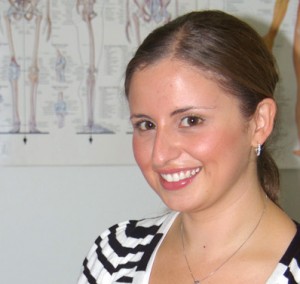Spinal health & the schoolbag
School bags have changed quite a lot since I was in school. I remember having a two–handled bag, which I’d wear with one handle on my shoulder and the other left dangling down, half way down my side. Then there were the cool kids that had the big ‘Country Road’ or ‘Sportsgirl’ duffle bags, chock full of stuff and worn again, slung over the shoulder, with one handle left to dangle. We used to walk for ages with these heavy bags, full of books and sport uniforms and just stuff. We did it every school day. When I think back to how we used to carry our bags it makes me cringe! What bad habits we had, and we thought we were so cool! Luckily school bags have improved a lot since then, backpacks now being the only choice for some schools, and so has our awareness of the importance of correctly fitting bags on a growing spine.
The human spine, or vertebral column is made up of 26 bones in the adult body – 24 separate vertebrae interspaced with cartilage, and then the sacrum, (or tail bone) and coccyx. Prior to adolescence, the spine consists of 33 bones because the sacrum’s five bones and the coccyx’s four little vertebrae do not fuse together until adolescence or even in your early 20’s.
The vertebrae are named by the first letter of their region and with a number to indicate their position along the spine. There are 7 Cervical Vertebrae in the neck: C1 to C7, then there are 12 Thoracic Vertebrae in the upper to mid back: T1 to T12. The lower back consists of 5 Lumbar Vertebrae: L1 to L5, followed by the sacrum and then the coccyx. Between each vertebrae of the spine are thin regions of cartilage known as intervertebral discs. The discs function to bind the vertebrae together and are flexible enough to allow for spinal movements. The discs also absorb shock and help support the body’s weight under strain, like carrying heavy school bags, or anything heavy for that matter.
The vertebrae of the spine align so that their vertebral canals form a hollow, bony tube to protect the spinal cord from external damage and infection. Between the vertebrae are small spaces known as intervertebral canals that allow spinal nerves to exit the spinal cord and connect to the various regions of the body. Clearly we need to take care of our bony spine as it houses and protects our spinal cord and all the nerves that exit from it, to control the functions of our body.
So what are the most important points to remember when fitting your child’s school backpack?
- Firstly, make sure you buy the right size for your child, and if possible a backpack that has padded and adjustable straps. If it has a waist strap, even better, as fixing it around the waist helps balance weight evenly across their hips and keeps the backpack still and supported on their back, so it doesn’t drag down or jump around when they run.
- Make sure they wear both their straps, when carrying the backpack, so that they are balancing weight evenly across their shoulders and therefore their spine.
- Don’t let them carry the bag too low, it’ll drag their shoulders down and they’ll compensate by hunching forward. Adjust the straps so that the bottom of the bag sits no lower than, well, the top of their bottom.
- Limit how much they are bringing to school, if possible. Books can be heavy, but even drink bottles and food add to the weight of the bag. Not to mention some kids now carrying iPads or laptops as well as sport uniforms etc. Pack the heaviest items in the bottom so they are closest to the base of the spine. Research is saying that backpacks should ideally be no heavier than 10- 15% of a student’s weight when packed. How many of you have put a full school bag on the scales to see how much it weighs? Could be an interesting experiment at home.
Keep reminding the kids of the above points, as school bags are used every school day over many years, so they will need monitoring as your children grow and their needs change. Set them up for good posture and good bag-carrying habits and you’ll be doing a favour for their spinal health. Don’t forget you can always ask your Osteopath if you need any help with correctly fitting your child’s backpack. Now, is it home-time yet?…..
Regards,
Daniela De Fazio
Registered Osteopath

